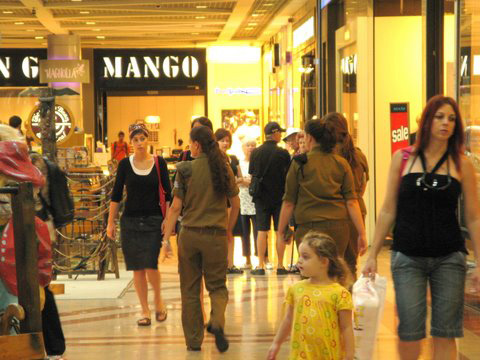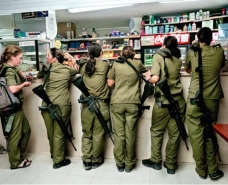Invisible militarism in Israel

Ruti Kantor and Diana Dolev -
Photo: Militarised Parenting: Three generations share the joy of this child's possible future (Weapons Expo, Israel, 2008) (credit – Activestills)
Background
Militarism is strongly embedded in Israeli society and the education system is, from a very early age, a powerful agent for it. The central place of the army in each Jewish individual's life is demonstrated daily: some people customarily congratulate parents on the birth of a new boy with: 'Mazal Tov! a new soldier is born!' Every kindergarten and school marks and praises military victories and conducts ceremonies in memory of fallen soldiers. Fathers and older brothers of the children, who may themselves be soldiers, often take part in these ceremonies. Children are exposed to tanks, fighter planes and various kinds of weaponry as part of their education and daily routine.
Referring to the concept of militarisation in the context of education in Israel, education researcher and former New Profile activist Haggith Gor wrote in The Militarisation of Education (2005):
Militarism is a system of values and beliefs that views the use of military force as a suitable means of solving political problems and obtaining political power...Militarisation is the spreading of militarism as ideology and the strengthening of the influence the military has as a social institution. Militarisation processes create a social climate that prepares civilians to accepting war, they create an atmosphere in which the central status of the military appears natural and military solutions to political problems appear reasonable. Militarisation processes happen step by step...Militarisation creeps into people’s daily routine.[1]
The presence of the military and militarism in public space is Israel is so much part of our daily routine, so close to us, that we do not see them for what they really are. Unless we develop an awareness of their various appearances we cannot recognise the messages of violence and war that they carry. Thus militaristic messages become normalised and harmless. Or rather, they become an important component of our identity. It is the government education system that acts as a key agent in creating this identity; young people are particularly exposed to this visual militarism, and they are probably even more susceptible to it – even less likely to reflect critically about it – than adults. However, through counter-education we can reverse this militarisation, creating minds that are capable of seeing things critically for what they really are. This article explores some examples of militarisation of Israeli public space, and describes daily responses to them.
Examples
 Photo: Most Israelis, seeing combat soldiers at a bus station, will probably think about the hardships of combat service, and feel sympathy and pride (credit – Esti Tsal)
Photo: Most Israelis, seeing combat soldiers at a bus station, will probably think about the hardships of combat service, and feel sympathy and pride (credit – Esti Tsal)
Our civilian environment contains many military images, including armed and uniformed soldiers and military vehicles (both on and off duty), which our children encounter very frequently. Are we really aware of their presence and the consequences?
We can all identify some military and militaristic images, even when they appear in advertisements and computer games. Yet we are unaware of some very conspicuous military and militaristic images in civilian public spaces. Their militaristic nature seems to become concealed, invisible. Perhaps from repeated exposure we have actually trained ourselves to overlook the appearance of militarism in a civilian environment.
Among militarised spaces in Israel, those that are not recognised as such by the general public include, to give just a few typical examples, an art gallery placed in a military memorial hall, a cartoon figure from an advertisement for a lottery wearing a military identification tag, and an old cannon in a public park next to a playground.
Militarism's layers of visibility
Militarism has different layers of visibility. The first one is the highly visible layer, which we can all easily identify: an army base, a tank, a military uniform, a soldier. The second is the semi-concealed, less obvious layer, like popular military video games. The third consists of invisible or hidden militarism, such as the symbolic military tags that people in Israel wear to commemorate dead soldiers. Becoming aware of militaristic messages can be the result of developing an anti-militarist point of view, as this provides a critical lens through which to observe the world.
In the centre of the town of Binyamina, next to the municipal building and the central synagogue, there is a park. National and local public celebrations take place there, and children go to the park with their families on a daily basis. In this park a memorial wall for dead soldiers has been constructed next to a memorial monument for Holocaust victims.
From a young age, Jewish children in Israel are taught to believe that Jews are always under existential threat, and that the solution is to maintain a strong military and be prepared to die for Israel. The two adjacent memorials in the Binyamina park, as well as the proximity between Israel’s Holocaust Memorial Day, the memorial day for Israeli war casualties and Israel’s Independence Day (all three taking place within eight days), are powerful means for reinforcing this message. This raises various questions: how should we train ourselves to actually see and be conscious of invisible militarism in our civil environment? What direct action should we take in order to raise awareness and to avoid concealing the militaristic message in different phenomena?
 Photo: Wherever you go in Israel, you are likely to come across soldiers, often carrying guns. It is a fact of everyday life (credit – Esti Tsal)
Photo: Wherever you go in Israel, you are likely to come across soldiers, often carrying guns. It is a fact of everyday life (credit – Esti Tsal)
There are many ways in which we can take action. Often this means improving our own ability to recognise subtle forms of militarism, as well as educating the non-antimilitarist majority. Ideas include:
- producing a photographic exhibition, or film, that documents the different layers of visibility of militarism in your country, and sharing it online
- doing street theatre in response to military propaganda (perhaps highlighting the physical and mental injuries that war causes to both soldiers and civilians)
- holding alternative mirroring events such as the sale and promotion of white peace poppies (instead of the red Remembrance poppies, now inextricably linked to the current armed forces and the pressure to be supportive of them) in the UK
-
placing peace symbols such as the rainbow flag and broken rifle badges in as many visible locations as possible
Sharing experiences and ideas of documenting and countering militarism and its symbols will help us to build the necessary awareness to 'read' our militaristic environments. Together we can unveil the less-visible forms of militarism. This will lead to a greater consciousness of the militarisation of society, which should bring about positive and effective responses, such as protests against the presence of weapons as glorifying monuments in public spaces (and especially in children's' playgrounds), and lobbying the Ministry of Defence to separate itself from school curricula. In order to do this, we must identify the reasons for our lack of awareness and the danger that this carries when the military is a normal component of the civilian environment. We need to look especially at the impact of this phenomenon on young people, and explore ways to challenge it and to realise alternative, demilitarised public space and symbology.
Notes
[1] Haggith Gor (ed.), The Militarization of Education (Tel-Aviv, 2005), p. 10.
Source: http://www.wri-irg.org
Countering Military Recruitment

WRI's new booklet, Countering Military Recruitment: Learning the lessons of counter-recruitment campaigns internationally, is out now. The booklet includes examples of campaigning against youth militarisation across different countries with the contribution of grassroot activists.
You can order a paperback version here.








